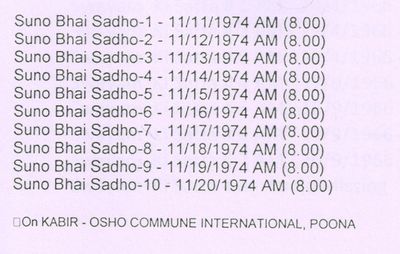Talk:Suno Bhai Sadho (सुनो भई साधो)
The main item here is the merger of Suno with Kasturi Kundal Basai (कस्तूरी कुंडल बसै). Other publishing details follow.
Discourses for Suno were indeed given as a series of ten talks from Nov 11 to 20, 1974. But Indian audio sites all offer it as a twenty-discourse series. Osho World offers no more info than that, Message From Saints calls its offering Suno Bhai Sadho (Kabir) aka Kasturi Kundal Basai, while Tao Vision is the clearest, as it is with most multi-title series, by indicating two ten-discourse series, one called Suno Bhai Sadho (Suno Bhai Sadho), the other Suno Bhai Sadho (Kasturi Kundal Basai). Talks for Kasturi were given Mar 11 to 20, 1975, not that far away, but even at that, there was another Kabir Hindi series between them, which had its own merger with a series from 1977. Some impressive weaving going on!
About the editions, the first one of Suno, in 1976, seems to have been purely Suno, with nothing added. The 2001 edition, with suddenly many more pages, seems to have adopted Kasturi, but it's not mentioned in info about the book. Perhaps it's clear in the book itself. The subtitle is something else again, unrelated and unhelpful.
That subtitle appears to appear also on the cover of the 2003 edition. Hard to tell, since the image is so low-res but it's the only one available. Its ISBN 8176210939 has two numbers switched and doesn't work and there's no other info. Strange for a supposedly more recent edition. Perhaps it was never really an edition, just an image created, say for mp3 sales?
About the first (1976) edition, its subtitle was surely in Hindi, so i took the liberty of moving its English descriptive text into "Notes" for the book in general. -- Sarlo (talk) 23:11, 4 May 2014 (PDT)
And a TOC found in a search for Ghoonghat Ke Pat Khol (घूंघट के पट खोल) (compilation), a separate small book said to have been made from the last four chapters, found in osho.com's audiobook offerings:
- 1. माया महाठगिनी हम जानी
- 2. मन गोरख मन गोविंदौ (the image of TOC of the 1988 edition has difference - the last word "गोविन्दौ", see below)
- 3. अपन पौ आपु ही बिसरो
- 4. गुरु कुम्हार सिष कुंभ है
- 5. झीनी झीनी बिनी चदरिया
- 6. भक्ति का मारग झीना रे
- 7. घूंघट के पट खोल रे
- 8. संतो जागत नींद न कीजै
- 9. रस गगन गुफा में अजर झरै
- 10. मन मस्त हुआ फिर क्यों बोले
It will be observed that talk #7 isn't exactly घूंघट के पट खोल but has an extra word रे. In Kabir's bhajan, the first line does indeed include that word. Why it was left off to make Ghoonghat and why it was put back in, in the Gujarati translation of same, shall have to remain a mystery for now. -- doofus-9 16:00, 9 July 2017 (UTC)
Will eventually get around to working up the pub info and 20-chapter TOC for the 1988 edition. For now, the publisher, "Manan Rajneesh Dhyan Kendra, Mahesana Gujarat", is an authentic transliteration of what it says in the pub info page. Manan is a big Osho center in Gujarat, in fact now it is Manan Osho Sannyas Ashram. Their town / district is also rendered as Mehsana, which shows up as their address in another book they have published. -- doofus-9 04:02, 27 January 2018 (UTC)

The 20-chapter TOC in the 1988 edition has been checked now and we're happy to report that there is only one small difference between its first ten chapters and the ten above, and that is the different way of rendering the last word of the title of ch 2, गोविन्दौ instead of गोविंदौ. If there's an issue of correctness, more likely osho.com's गोविंदौ is correct.
Interestingly, there is an analogous difference between Manan's 1988 edition and usual usage in ch 18: Kranti ("Revolution") is a common word in Osho's titles and is always done as क्रांति in other titles. Here it is क्रान्ति, exactly the same substitution, the combining form of a न (na) for a nasalizing anusvara diacritic. In this case, it can likely be deemed an error.
And about the ~490 page count of the 1988 Manan edition, that is a rough estimate, based on a projection of the TOC, and compared with the 2001 edition. The text and other contents are likely to be very similar, as the crew that actually worked on it was the usual Pune crew. -- doofus-9 04:06, 26 February 2018 (UTC)
- 11. अन्तर्यात्रा के मूल सूत्र
- 12. धर्म कला है -- मृत्यु की, अमृत की
- 13. मन के जाल हजार
- 14. विराम है द्वार राम का
- 15. धर्म और संप्रदाय
- 16. अभीप्सा की आग : अमृत की वर्षा
- 17. मन रे जागत रहिये भाई
- 18. शिष्यत्व महान क्रान्ति है
- 19. प्रार्थना है उत्सव
- 20. उपलब्धि के अंतिम चरण
